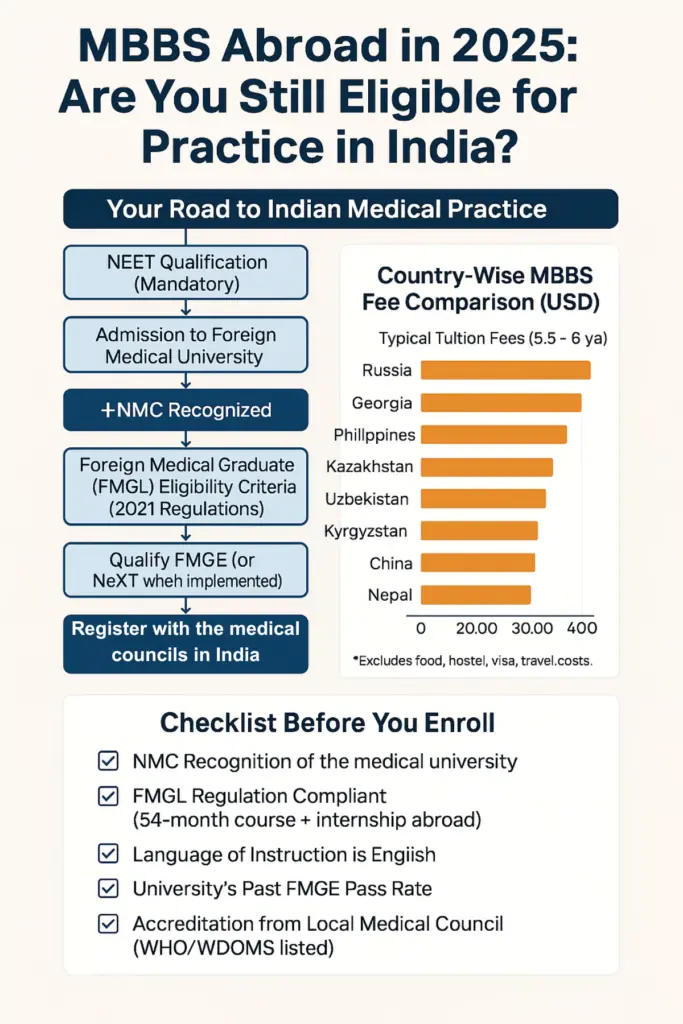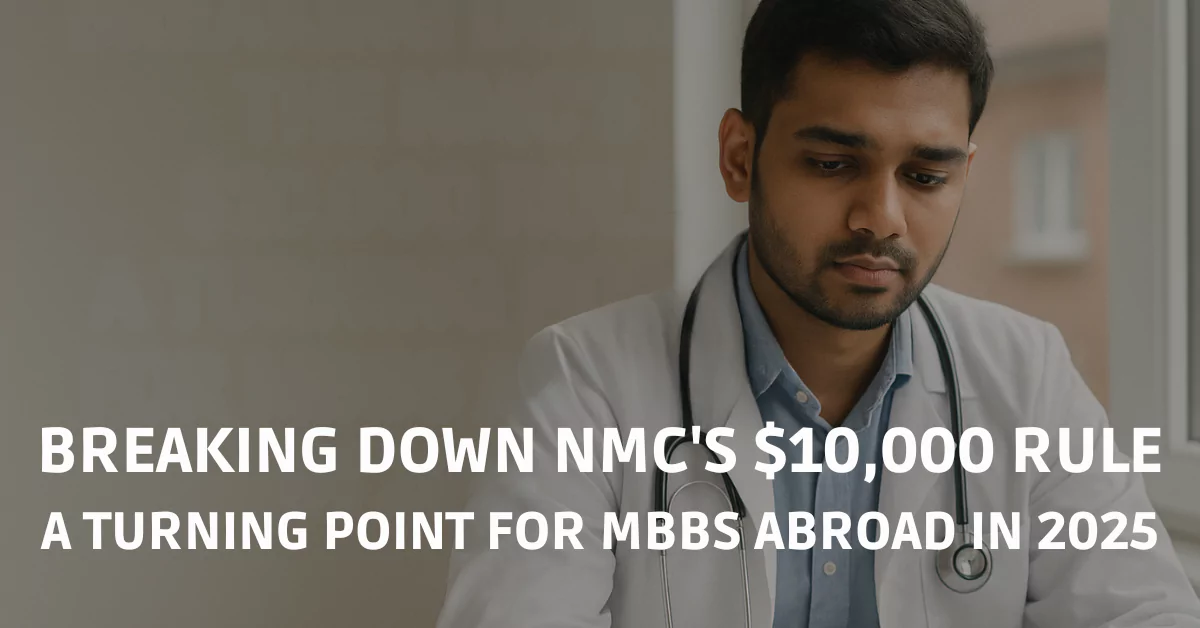Blog Summary
- NMC has proposed a $10,000 fee per qualification for MBBS Abroad Medical Universities seeking recognition in India.
- This is part of the 2025 amendment to the “Recognition of Medical Qualification Regulations, 2023”
- Without NMC recognition, foreign MBBS graduates cannot appear for the FMGE
- Similar recognition fees exist in countries like the US, UK, and Canada
India is home to one of the most competitive medical entrance exams in the world, the National Eligilibility-cum-Entrance Test (NEET UG), with over 25 lakh aspirants competing for just 1.18 lakh MBBS seats in 2024. For lakhs of aspiring doctors, studying MBBS Abroad has emerged as a practical and affordable option. Countries like Russia, Georgia, China, Kyrgyzstan, and Nepal offer affordable medical degrees with relatively lower entry barriers.
However, a recent proposal by the National Medical Commission (NMC) may change it. As per the draft amendment to the National Medical Commission (Recognition of Medical Qualification) Regulations, 2023, foreign universities will now have to pay a one-time $10,000 fee per qualification to get recognised in India.
Subscribe to RM Group of Education Newsletter, Get Admission, Fees, Seats etc.
This blog will explain this regulation, its implications, and how it intersects with the Foreign Medical Graduate Licentiate (FMGL) Regulations, 2021, a crucial filter that determines if an MBBS Abroad will be valid for practice in India.
The $10,000 Clause: What the New Draft Regulation Says?
On 22 July 2025, the NMC released a draft amendment titled:
“National Medical Commission (Recognition of Medical Qualification) Regulations (Amendment), 2025”
This amendment modifies Clause 7, which previously discussed the process and fees for the application. The updated clause reads:
“Any foreign authority in any country outside India, entrusted with the recognition shall remit $10,000 (US dollars ten thousand only) per qualification as fees to the Commission while submitting its application in a proforma.”
The National Medical Commission (Recognition of Medical Qualification) Regulations (Amendment), 2025
It is based on the draft officially published in the Gazette of India on 16 July 2025.
Key Amendments in the 2025 Draft
1. Removal of ₹2.5 lakh Individual Fee (Clause 7)
- Under the earlier (2023) regulations, individual applicants, such as foreign‑educated Indian doctors, were required to pay an application fee of ₹2,50,000 per qualification. That provision has been deleted in the 2025 amendment draft.
2. Imposition of $10,000 Fee on Foreign Authorities
- Now, only foreign universities or accreditation agencies seeking recognition of their qualifications in India must pay a fee of USD 10,000 per qualification when submitting their application in the prescribed proforma to the NMC.
3. Scope & Applicability
- The amendment applies to applications for recognition of foreign medical qualifications, not Indian degrees. It shifts the financial burden from individual aspirants to institutional authorities abroad.
4. Effective Date & Consultation Process
- The draft amendment will come into effect after due consultation.
- NMC has invited public comments within 30 days of the Gazette notification. Feedback is to be submitted via a designated email to the Director (PGMEB), NMC, using the prescribed format.
Context & Rationale
- The original 2023 Regulations required Indian doctors educated abroad to pay Rs 2.5 lakh per qualification for recognition by NMC.
- The 2025 amendment aims to align recognition practices with global norms, shifting recognition fees to foreign institutions, similar to systems in the US, Canada, and the UK
According to NMC officials and medical policy experts, the fee is not merely a revenue-generating mechanism. Instead, it’s seen as a quality control and filtering tool.
Goals Behind the Fee:
- Discourage low-quality foreign institutions from seeking recognition.
- Ensure only serious, compliant, and globally accepted institutions apply.
- Standardise the recognition process, similar to international norms.
- Bring transparency and accountability into MBBS abroad degrees.
Global Comparison: This Isn’t Just an Indian Phenomenon
Charging for medical qualification recognition is standard practice globally. Let’s take a look:
| Country / Body | Recognition Fee (Approx.) | Purpose |
|---|---|---|
| WFME (World Federation) | ~$60,000 | Accrediting national agencies |
| ECFMG (USA) | ~$4,000–$5,000 | Credential verification |
| GMC (UK) | £406–£1,000+ | Per applicant (not university) |
| Medical Council of Canada | CAD $2,570 | Application + exam cost |
| India (NMC, Proposed) | $10,000 per program | For foreign university recognition |
By aligning with this global structure, India seeks to strengthen regulatory oversight while safeguarding Indian students from enrolling in substandard foreign institutions.
The FMGL Regulations, 2021: The Other Gatekeeper
The Foreign Medical Graduate Licentiate (FMGL) Regulations, 2021, were a game-changer in medical education. It introduced minimum academic, infrastructural, and clinical criteria for foreign MBBS degrees to be valid in India.
Key FMGL Conditions:
- 54-month MBBS course duration.
- 12-month compulsory internship in the same country.
- The entire course, including practical training, must be in English.
- A medical degree must be recognised by the authority of that country.
- The student must be registered to practice medicine in the same foreign country.
With the $10,000 NMC recognition fee, another layer has been added; foreign universities must now be recognised by India first, before their students can even sit for FMGE.

Impact on Indian MBBS Aspirants
The Numbers:
- ~25,000 Indian students go abroad each year for MBBS.
- Over 80% of them choose low-cost destinations like Russia, Georgia, Kyrgyzstan, or Kazakhstan.
- India has only 1.18 lakh MBBS seats for 25 lakh NEET takers.
What Changes Now?
- If a university doesn’t pay the fee, Indian students from that university may not be eligible to appear in the FMGE.
- Future MBBS aspirants will need to double-check university recognition on NMC’s portal.
- Financial burden may increase as universities pass on the $10,000 cost to students (via higher tuition).
- Students stuck in non-compliant universities may face career uncertainty.
- Smaller but legitimate institutions in foreign countries may back out of applying due to high fees.
Sanjay Tiwari, Medical Education Consultant: “This move is long overdue. We need to separate fly-by-night operators from genuine foreign universities. But the implementation must be fair and transparent.”
Pooja Sharma, Parent of NEET aspirant: “We were planning Georgia or Uzbekistan. Now we’re confused if our choice will even be valid in India next year.”
Overseas Education Consultant: “Some universities in Eastern Europe are small and good but can’t afford high application fees. We may see reduced options for students from modest backgrounds.”
How Foreign Universities May React
Foreign medical institutions now have to decide between two options:
- Pay the $10,000 and apply for NMC recognition, ensuring their Indian students’ degrees are valid.
- Avoid applying, thereby losing access to thousands of Indian students each year.
Implications:
- Large universities in Russia, China, Georgia, and Kazakhstan will likely comply.
- Smaller or new institutions may disappear from Indian admission portals.
- The market may become more consolidated and standardised.
Will This Affect FMGE Eligibility?
Absolutely. NMC has made it clear that only students graduating from recognised foreign universities can:
- Appear for FMGE (Foreign Medical Graduate Exam).
- Get provisional registration with the State Medical Council in India.
- Begin an internship and practice in India.
So, unless the foreign university pays the $10,000 and gets approved, students will be ineligible to become doctors in India, regardless of how well they perform academically abroad.
Cost of MBBS Abroad vs India
| Country | Average Cost (Tuition + Living, Full Course) |
|---|---|
| Russia | ₹30–50 lakh |
| Georgia | ₹28–45 lakh |
| China | ₹32–60 lakh |
| Kyrgyzstan | ₹25–50 lakh |
| India (Private) | ₹50 lakh–₹1.5 crore |
Despite the new NMC regulation, MBBS Abroad remains a more affordable choice compared to many private medical colleges in India. This reality may continue to push Indian students abroad, though now with greater caution.
What Students Should Do Now
- Check NMC’s updated recognition list before selecting any foreign university.
- Monitor official gazette notifications for implementation timelines.
- Ask universities about their NMC application status.
- Confirm if your chosen course meets FMGL conditions (duration, language, internship).
- Consult experienced MBBS abroad consultants, but cross-verify everything.
- Prepare for FMGE with renewed seriousness.
Is the $10,000 Fee a Blessing or Barrier?
The NMC’s move to charge a $10,000 recognition fee has opened a new chapter in India’s foreign medical education policy. On the one hand, it could bring quality control, transparency, and better healthcare standards. On the other hand, it could create regulatory bottlenecks and reduce access to legitimate but small foreign institutions.
For Indian students, this development means one thing above all: Research well, choose wisely, and always check the latest NMC notifications.


